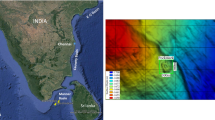Abstract
During a research cruise in July 1997 in the Gulf of Mexico we discovered a gas hydrate approximately 1 m thick and over 2 m in diameter which had recently breached the sea floor at a depth of 540 m. The hydrate surface visible from the submarine was considerably greater than that of any other reported hydrate. Two distinct color bands of hydrate were present in the same mound, and the entire exposed surface of the hydrate was infested (2500 individuals/m2) with 2 to 4 cm-long worms, since described as a new species, Hesiocaeca methanicola, in the polychaete family Hesionidae (Desbruyères and Toulmond 1998). H. methanicola tissue stable isotope values are consistent with a chemoautotrophic food source. No evidence of chemoautotrophic symbionts was detected, but geochemical data support the presence of abundant free living bacteria on the hydrate. The activities of the polychaetes, grazing on the hydrate bacteria and supplying oxygen to their habitats, appears to contribute to the dissolution of hydrates in surface sediments.
Similar content being viewed by others
Author information
Authors and Affiliations
Additional information
Received: 16 August 1999 / Accepted in revised form: 19 January 2000
Rights and permissions
About this article
Cite this article
Fisher, C., MacDonald, I., Sassen, R. et al. Methane Ice Worms: Hesiocaeca methanicola Colonizing Fossil Fuel Reserves. Naturwissenschaften 87, 184–187 (2000). https://doi.org/10.1007/s001140050700
Issue Date:
DOI: https://doi.org/10.1007/s001140050700




